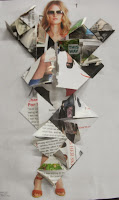Tuesday 17th September:
Lens Based Media Day 2:
We spent the day looking at narratives, watching movie shorts, looking at the works of Peter Mullan and Jane Campion, to form a basic idea of storytelling structure before starting to think up storyboards of our own in which we would tell a story in 6 still pictures and stages.
Still 1) Introduces an 'ordinary world'; the background of the tale in which the protagonist functions.
2) Presents a problem, a change or challenge in the everyday routine which we have just been shown.
3, 4&5) Show the struggles with this problem/change, normally escalating or in some way linked, to lead to a climax and build emotion.
6) Shows us the solution to this problem, perhaps with a return to the ordinary world or in which a new normality is created.
I really enjoyed the Jane Campion shorts as they were 40-second films that dealt well with the basic narrative structure of beginning, middle, end etc. while also creating shorts that had represented and evoked real emotions.
After studying these ideas and thinking about how narratives are built and how they can capture our emotions and interest, we separated into groups. In these groups we drew things from our lives- interesting people and places we knew, what we thought joy and fear looked like etc:
Then in these groups we talked about the various people and places in our respective lives, combining them to create short stories that could be told through a 6 picture storyboard. e.g. the Minotaur from Florence's nightmares living in the void of Rosie's as an ordinary world around which we would then create a story. After discussing these we came up with three finalised ideas and drew them out:
This project was interesting as I really enjoyed the principles of storytelling and although I thought it might be difficult to write stories in groups, the input of everyone and bouncing ideas off each other was actually really fun and productive, enabling us to come up with slightly bizarre and interesting stories. At the end of the day we were told to create our own stories and photograph them in our self-directed-study day. I actually found this more difficult than group work and it took me a while to form any coherent ideas. I toyed around with a couple before deciding to shoot this one:






Using blue tac models I photographed a story in which a postcard image comes to life. Realising that he is now alone in the real world the protagonist tries to climb back in to his friend, and when that doesn't work he tries to call her out to him. In the end he is left alone on the edge of his world, facing a reality he does not know. I had a bit of difficulty cutting this down to only 6 images and originally had a longer story in which the character wanders the new world a bit, looking at other pictures until he realises he is in fact alone, unlike anyone on the postcards and world he sees, before trying to return to his friend. I tried to make the lighting darker as the character struggles (which really just succeeded in making the picture blurrier).
In college the next day we were told to re-examine and develop the storyboards we had created. Several plot holes and weaknesses became apparent in mine, for example the lack of a reason or catalyst for the protagonist coming to life and the slightly unresolved ending. I looked at different ways of recreating the story but in the end scrapped all the pictures and only kept the basic premise of an inanimate picture coming to life and struggling with loneliness in some aspects.






In my new story, two postcards, pictures of a lonely boy and girl, come to life at midnight and meet each other. They explore the other pictures on the wall. Dancing in Paris on Bastille day, being chased by a leviathan, and swinging from the girders in 'Lunchtime atop a Skyscraper' they start to fall in love. However, as the hour comes to and end they prepare to part as they know they have to under the Eiffel Tower. As one o'clock is seconds away they run to try and make it back to their pictures in time. The final image of the storyboard shows that the two managed to stay together and so they remain. I brought in the idea of moving through the other pictures which I scrapped in the previous storyboard as it proved popular with my peers. Despite going through a lot of ideas before reaching this one I picked this as it had the happiest ending. I enjoyed this project a lot overall though would have liked to work with a larger range, perhaps getting a chance to stop-motion animate my storyboard so as to develop the characters' emotions and struggles further.





























































